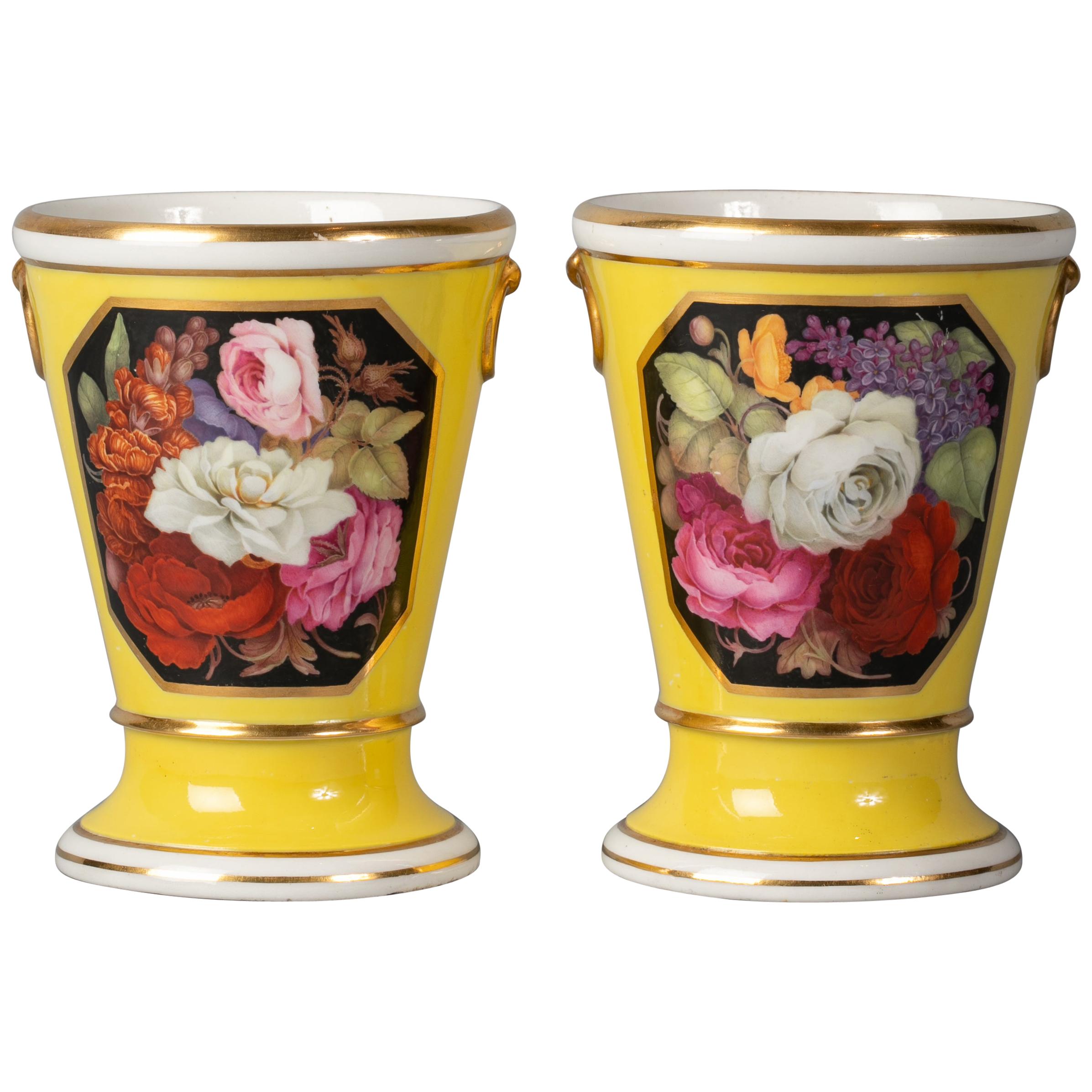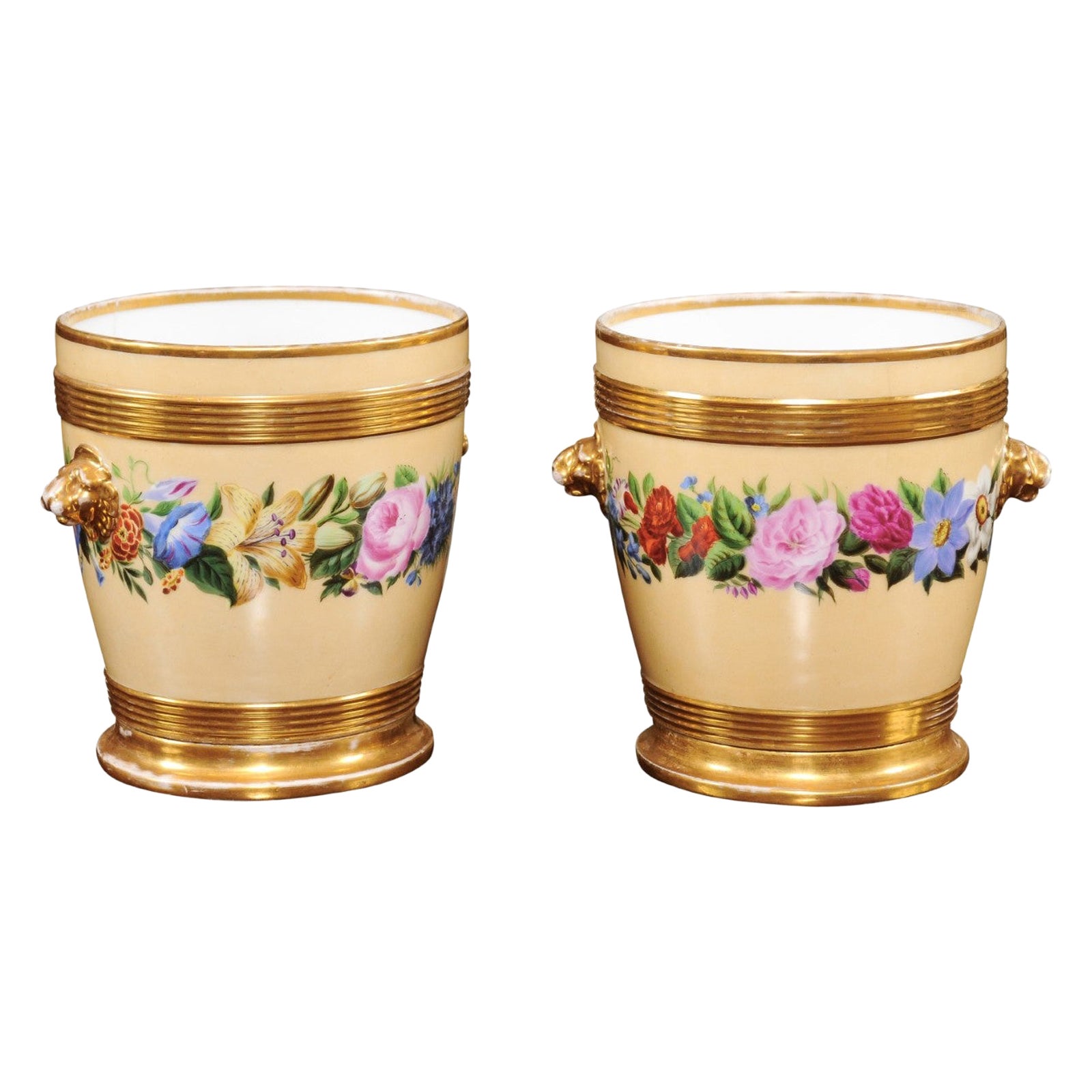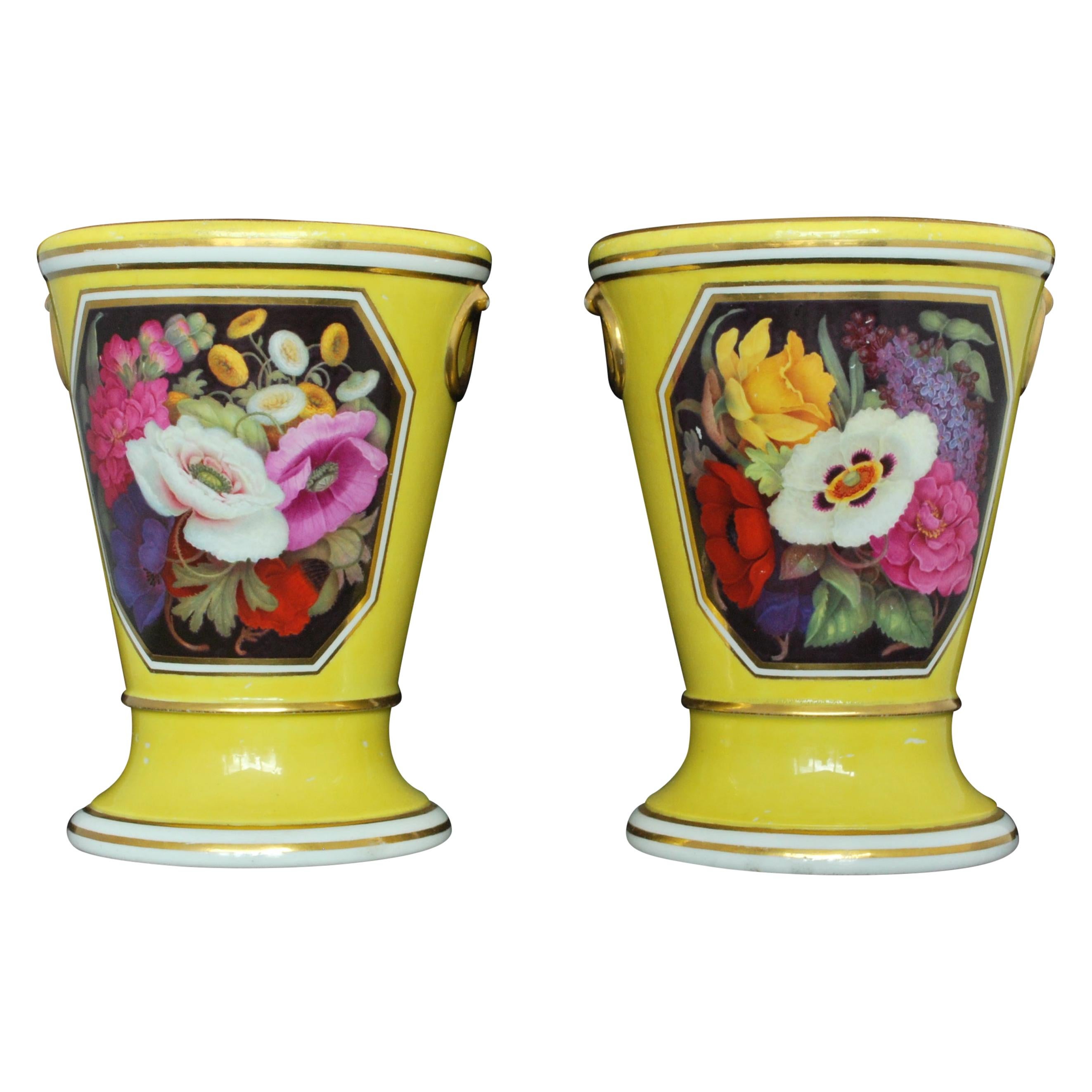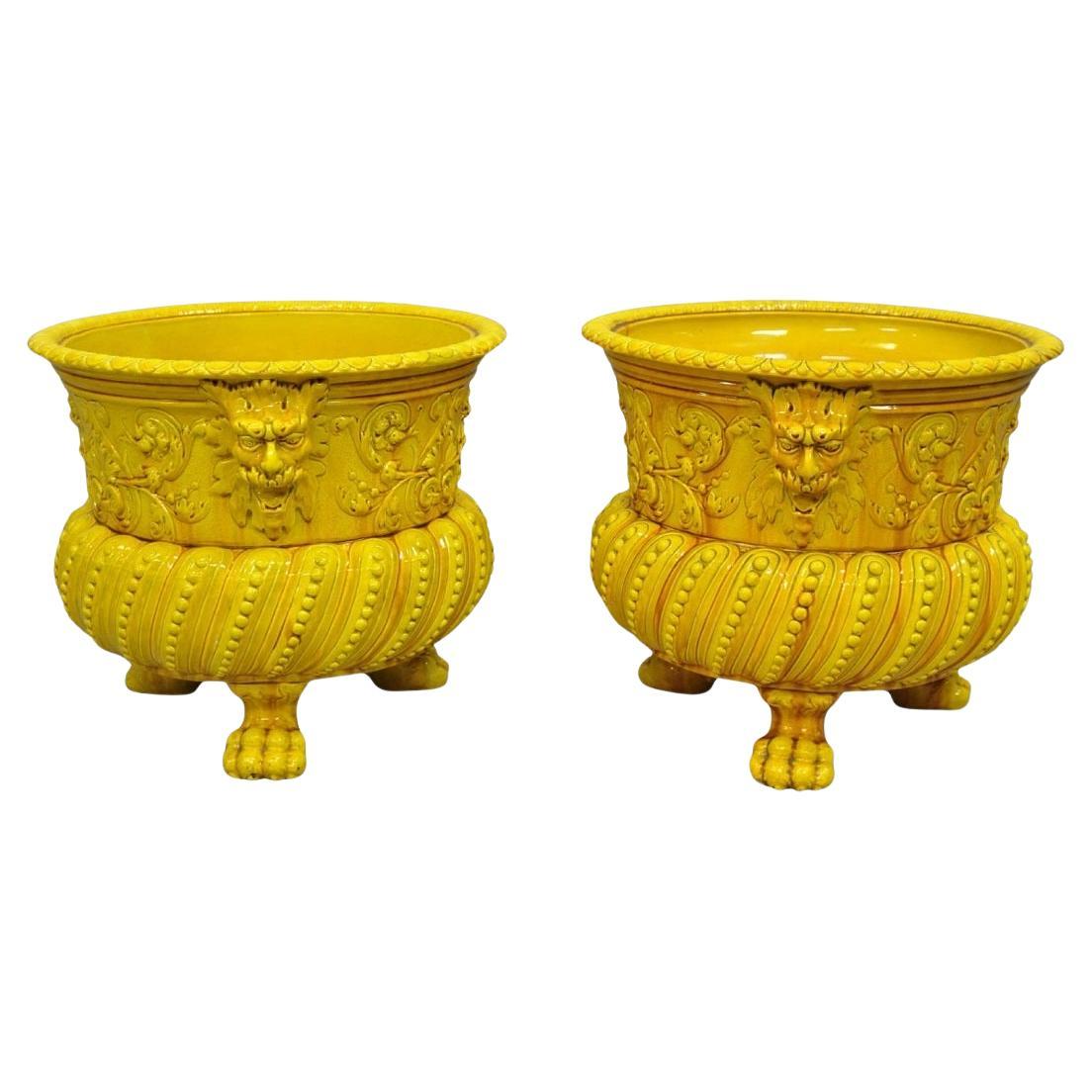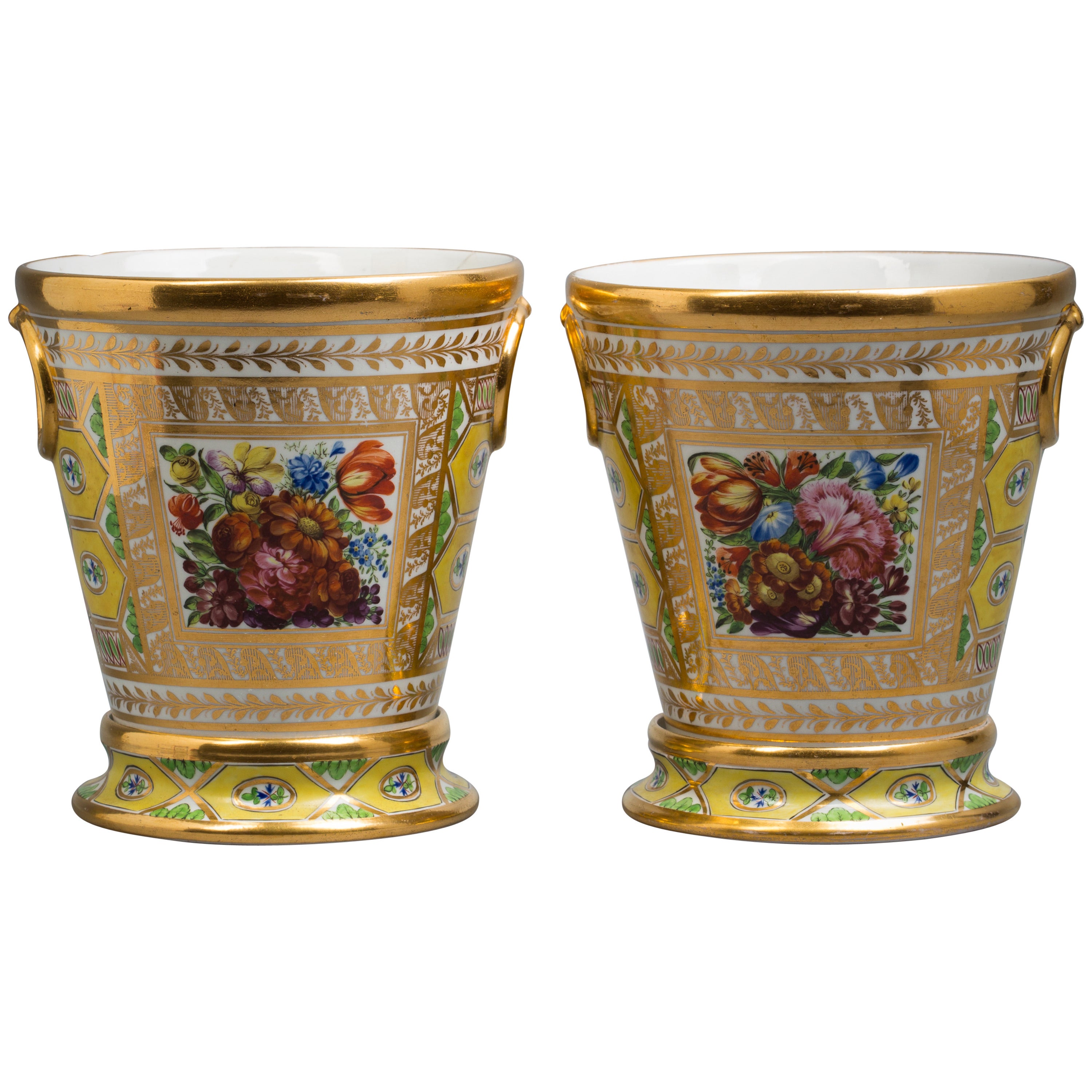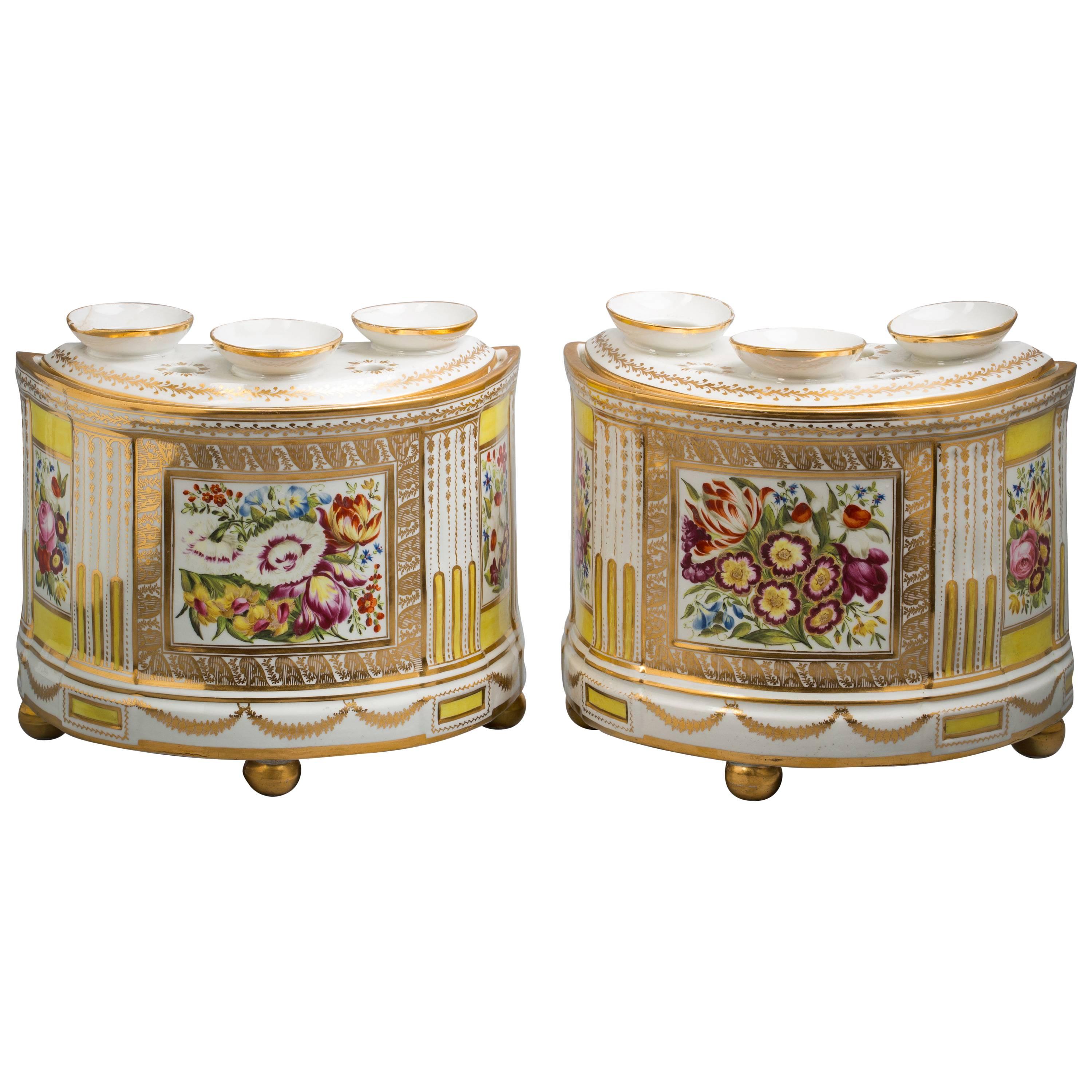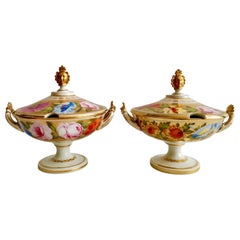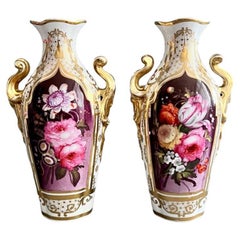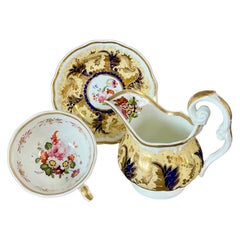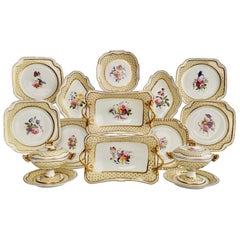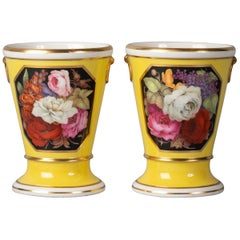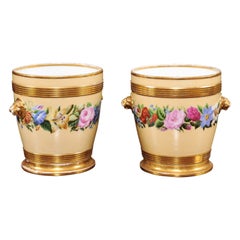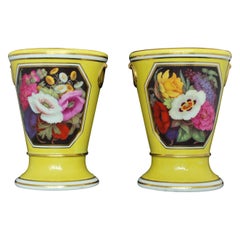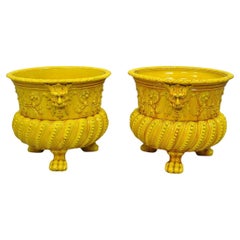Items Similar to Derby Pair of Cache Pots, Yellow, Flowers by William Billingsley, ca 1795
Want more images or videos?
Request additional images or videos from the seller
1 of 17
Derby Pair of Cache Pots, Yellow, Flowers by William Billingsley, ca 1795
$2,425
£1,838.48
€2,119.28
CA$3,415.22
A$3,787.23
CHF 1,989.91
MX$46,273.52
NOK 24,896.47
SEK 23,369.59
DKK 15,820.88
About the Item
This is a pair of cache pots made by the Derby Porcelain Company in 1795. The pair is decorated in bright canary or "Scarsdale" yellow and a white band with large flowers painted by the famous painter William Billingsley. The pots have gilded shell shaped handles.
The Derby Porcelain Company, later called Royal Crown Derby, is currently the oldest British porcelain factory still in production. The Derby pottery was one of the most prominent potteries right from the start of English porcelain production in the mid 1700s to today, and the factory went through many iterations. In the 1820s, it was called "Bloor Derby" as it came under the ownership of Robert Bloor; this factory later closed but its legacy was continued under the ownership of a group of employees, and later this was merged into a new factory called Royal Crown Derby, which is still in operation today and still carries forward some of the oldest patterns that have made it famous over the centuries.
William Billingsley was a brilliant but notoriously difficult man who left behind a trail of debts, broken hearts and mystery - but he was also one of the most important people in the history British porcelain. Billingsley revolutionised the way British decorators painted flowers; he added a freedom and artistry that now singles out British flower painting, and he created a new technique for painting roses, which you can see in this design. Billingsley worked at Derby, Worcester and Mansfield. He also set up his own potteries in Pinxton and Nantgarw and created some of the best porcelain ever made, but racking up great debts, before running off in the dead of night and ending his days at Coalport painting flowers.
Items painted by William Billingsley are rare and very much in demand - together with Thomas Baxter's work they are probably among the most desired pieces of British porcelain.
The pots are marked with the puce crowned Derby mark.
CONDITION REPORT The pots are in excellent antique condition without any damage, repairs or crazing, and only minor flaws. There is a bit of discolouration on the rim of one of the pots; there are two tiny scuffs off one of the pots, and overall there is minor rubbing or scratching to both pots, as visible in the pictures. At some point in time there has been a rectangular sticker on one of the pots; the faint remnants are visible in one of the images.
Antique British porcelain is never perfect. Kilns were fired on coal in the 1700s, and this meant that china from that period can have some firing specks from flying particles. British makers were also known for their experimentation, and sometimes this resulted in technically imperfect results. Due to the shrinkage in the kiln, items can have small firing lines or develop crazing over time, which should not be seen as damage but as an imperfection of the maker's recipes, probably unknown at the time of making. Items have often been used for many years and can have normal signs of wear, and gilt can have signs of slight disintegration even if never handled. I will reflect any damage, repairs, obvious stress marks, crazing or heavy wear in the item description but some minor scratches, nicks, stains and gilt disintegration can be normal for vintage items and need to be taken into account.
There is widespread confusion on the internet about the difference between chips and nicks, or hairlines and cracks. I will reflect any damage as truthfully as I can, i.e. a nick is a tiny bit of damage smaller than 1mm and a chip is something you can easily see with the eye; a glazing line is a break in the glazing only; hairline is extremely tight and/or superficial and not picked up by the finger; and a crack is obvious both to the eye and the finger. Etcetera - I try to be as accurate as I can and please feel free to ask questions or request more detailed pictures!
DIMENSIONS the pots are 15cm (6") wide incl. handles, and stand 13.5cm (5.25") tall.
- Creator:Derby (Maker),William Billingsly (Artist)
- Dimensions:Height: 5.25 in (13.34 cm)Diameter: 6 in (15.24 cm)
- Style:George III (Of the Period)
- Materials and Techniques:
- Place of Origin:
- Period:1790-1799
- Date of Manufacture:circa 1795
- Condition:Wear consistent with age and use. In perfect antique condition without damage, repairs or crazing, and minor rubbing.
- Seller Location:London, GB
- Reference Number:Seller: A-DER721stDibs: LU4805142341992
About the Seller
5.0
Vetted Professional Seller
Every seller passes strict standards for authenticity and reliability
Established in 2016
1stDibs seller since 2019
226 sales on 1stDibs
Typical response time: 2 hours
- ShippingRetrieving quote...Shipping from: London, United Kingdom
- Return Policy
Authenticity Guarantee
In the unlikely event there’s an issue with an item’s authenticity, contact us within 1 year for a full refund. DetailsMoney-Back Guarantee
If your item is not as described, is damaged in transit, or does not arrive, contact us within 7 days for a full refund. Details24-Hour Cancellation
You have a 24-hour grace period in which to reconsider your purchase, with no questions asked.Vetted Professional Sellers
Our world-class sellers must adhere to strict standards for service and quality, maintaining the integrity of our listings.Price-Match Guarantee
If you find that a seller listed the same item for a lower price elsewhere, we’ll match it.Trusted Global Delivery
Our best-in-class carrier network provides specialized shipping options worldwide, including custom delivery.More From This Seller
View AllCoalport Pair of Floral Gilded Sauce Tureens, Marquess of Anglesey, circa 1820
By Coalport Porcelain
Located in London, GB
This is an extremely rare set of lidded sauce tureens made by Coalport in circa 1820. The tureens are decorated in the "Marquess of Anglesey" pattern. These sauce tureens would have formed part of a large dessert service. They were used for the sauce to be served on ice cream or a cooked sweet dish, and the lids have holes for the sauce ladles.
Coalport was one of the leading potters in 19th and 20th century, coming out with many innovative designs. The pottery emerged around the year 1800 in Shropshire, right on the edge of Staffordshire and near other great makers such as Spode, Minton, Davenport and many others. They went on to become a major potter in the 19th century and brought out many iconic designs.
The Welsh Nantgarw factory first created the heavily gilded service for the Marquess of Anglesey, with beautifully painted flowers. Later the Swansea factory made additions to or copies of this service, and circa 1820 Coalport...
Category
Antique 1820s English Regency Porcelain
Materials
Porcelain
$3,950 / set
Free Shipping
Coalport Pair of Vases, Persian Revival Gilt with Puce Floral Reserves, ca 1845
By Coalport Porcelain
Located in London, GB
This is a stunning and very rare pair of vases made by Coalport in around 1845. The vases have rich gilding in the Persian Revival style, combined with very English floral reserves of freely painted flower bouquets on a puce ground. Incorporated into the gilding on the back of the vases is a very English swan...
Category
Antique 1840s English Rococo Revival Vases
Materials
Porcelain
$1,750 / set
Free Shipping
Samuel Alcock Teacup and Milk Jug, Pale Yellow, Gilt and Flowers, ca 1824
By Samuel Alcock & Co.
Located in London, GB
A teacup and saucer with milk jug in the “melted snow” shape with double drop handles, pale yellow ground with rich gilt and cobalt blue acanthus pattern and finely painted flower re...
Category
Antique 1820s English Regency Tea Sets
Materials
Porcelain
Spode Felspar Floral Dessert Service, Yellow, Butterfly Handles, circa 1822
By Spode
Located in London, GB
This is a stunning and very rare dessert service made by Spode in 1822, which was the Regency era. This beautiful service, which is in perfect condition, would be fantastic for a summer dinner party!
The service is made of Felspar porcelain and decorated in a beautiful pale yellow colour with an "Oeil de Perdrix" pattern and top quality floral reserves. The service consists of two lidded sauce tureens with stands, two deep rectangular dishes, two lozenge shaped dishes, one square dish, and six square dessert plates
Spode was the great Pioneer among the Georgian potters in England. Around the year 1800 he perfected the bone china recipe that has been used by British potters ever since, and he was also the leading potter behind the technique of transferware, making it possible for English potters to replace the Chinese export china...
Category
Antique 1820s English Regency Porcelain
Materials
Porcelain
Chelsea-Derby Chocolate Cup Set, Gilt Stripes, Puce Flowers, Rococo 1770-1775
By Chelsea-Derby, Chelsea Porcelain, Derby
Located in London, GB
This is a beautiful chocolate cup set made by Chelsea-Derby between 1770 and 1775, which was the Rococo era. The set consists of a cup, a saucer and a cover, and is decorated in a st...
Category
Antique 1770s English Rococo Tea Sets
Materials
Porcelain
$1,175 / set
Free Shipping
Samuel Alcock Pair of Low Comports, Grey, Gilt with Landscapes, Flowers, ca 1859
By Samuel Alcock & Co.
Located in London, GB
This is a rather stunning pair of one-handled low comports with pierced rims, a warm grey ground with elaborate gilt foliage, three very fine flower reserves each, and a large mounta...
Category
Antique 1850s English Rococo Revival Porcelain
Materials
Porcelain
$990 / set
Free Shipping
You May Also Like
Pair of English Porcelain Yellow-Ground Cachepots, Flight & Barr, ca 1800
Located in New York, NY
Pair of English porcelain yellow-ground cachepots, Worcester (Flight and Barr), circa 1800.
Puce script marks. Painted with a lush bouquet within an octagonal surround, flanked by gilt faux ring...
Category
Antique Early 1800s English Vases
Materials
Porcelain
Pair of 19th Century Paris Porcelain Cachepots with Yellow Ground & Floral Decor
Located in Atlanta, GA
Pair of 19th century Paris Porcelain cachepots with yellow ground & floral decoration.
Category
Antique 19th Century French Planters, Cachepots and Jardinières
Materials
Porcelain
Pair of Yellow Ground Vases, Chamberlain Worcester, circa 1805
By Chamberlains Worcester
Located in Melbourne, Victoria
A rare pair of yellow-ground vases or jardinières, with reserves of exquisite flower-painting or a quality seen only during this period.
Category
Antique Early 19th Century English Neoclassical Porcelain
Materials
Porcelain
Burmantofts Faience Majolica English Regency Yellow Glazed Jardiniere Pot - Pair
Located in Philadelphia, PA
Please message us with your zip code to request a more reasonable domestic U.S. shipping quote.
Antique Burmantofts Faience Majolica English Regency Yellow Glazed Figural Jardiniere...
Category
Antique Late 19th Century Unknown Regency Vases
Materials
Ceramic
Pair of English Porcelain Cachepots on Stands, Coalport, circa 1820
By Coalport Porcelain
Located in New York, NY
Pair of English porcelain yellow-ground cachepots on stands, Coalport, "Church Gresley" Pattern, circa 1820.
Category
Antique Early 19th Century English Planters, Cachepots and Jardinières
Materials
Porcelain
Pair of English Porcelain Demilune Boughpots and Covers, Coalport, circa 1820
By Coalport Porcelain
Located in New York, NY
Pair of yellow ground English porcelain demilune boughpots and covers, Coalport, circa 1820.
Category
Antique Early 19th Century English Planters, Cachepots and Jardinières
Materials
Porcelain
More Ways To Browse
Crown Silver Company
Hand Painted Large Pots
Antique Stickers
Chinese Flower Pot
Antique Pot Painting
Vintage Large Pot
Chinese Flower Pots
Large Chinese Pots
English 1700s
Canary Glass
Pair Royal Worcester
Antique Royal Worcester Patterns
Coalport China
Coalport Chinese Porcelain
Antique Royal Crown Derby Marks
Coalport White
Antique Royal Crown Derby Patterns
Royal Crown Derby Sets
